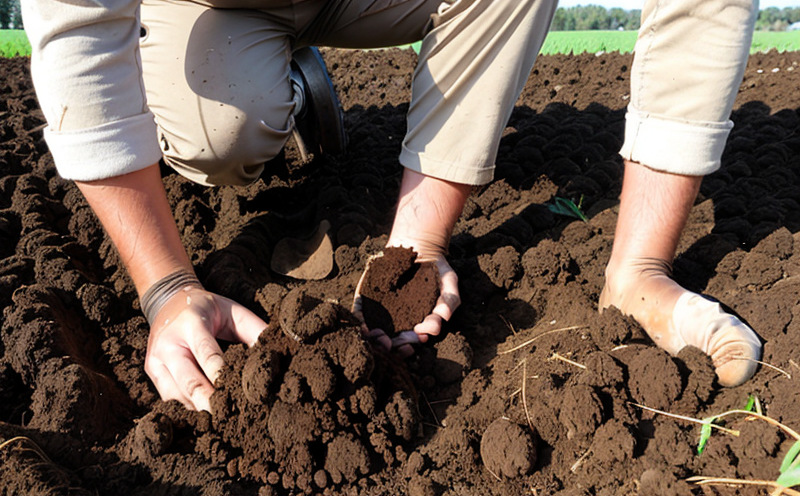Soil Nitrate-Nitrogen Testing
Soil nitrate-nitrogen testing is a critical aspect of soil quality and fertility assessment in agriculture and forestry. This service allows for the precise measurement of nitrate-nitrogen (NO₃⁻) concentration, which plays a pivotal role in plant nutrition, soil health, and environmental sustainability. Nitrate-nitrogen is one of the main forms of nitrogen that can be absorbed by plants, making it essential for optimizing crop yields while minimizing nutrient loss.
The ability to accurately measure nitrate-nitrogen levels enables farmers and foresters to make informed decisions about fertilization practices, irrigation management, and overall soil health. This testing ensures efficient use of resources, reduces the risk of environmental contamination, and promotes sustainable agricultural practices. In this article, we will explore the scope and methodology of soil nitrate-nitrogen testing, its international acceptance and recognition, its contributions to environmental sustainability, and frequently asked questions.
Before diving into these topics, it is important to note that accurate measurement requires careful sample preparation and analysis using precise laboratory methods. The standard technique for measuring soil nitrate-nitrogen involves extracting the soil sample with a suitable solvent, filtering the extract, and then determining the NO₃⁻ concentration through colorimetric or spectrophotometric analysis.
The significance of this service cannot be overstated, especially in the context of global agricultural challenges such as climate change and resource scarcity. By providing reliable data on soil nitrate-nitrogen levels, laboratories like ours contribute to more sustainable farming practices that enhance productivity while preserving natural resources.
Scope and Methodology
The scope of this testing includes the analysis of various types of agricultural soils and forestry substrates for their nitrate-nitrogen content. This service is particularly relevant for soil management, crop nutrition planning, environmental monitoring, and compliance with international standards.
| Sample Preparation | Analytical Method | Standard Compliance |
|---|---|---|
| Sieving the sample to ensure uniformity | Spectrophotometric analysis using UV/Vis spectrometer | ISO 14687:2015, EN ISO 14687:2015 |
The methodology for soil nitrate-nitrogen testing involves several key steps. First, the soil sample is sieved to ensure uniformity and minimize particle size effects. Next, a known volume of the extracted solution is diluted with water if necessary, ensuring that the NO₃⁻ concentration falls within the linear range of the calibration curve.
The analytical method typically used is spectrophotometric analysis, which involves measuring the absorbance of the sample at specific wavelengths corresponding to nitrate-nitrogen. The absorbance values are then compared against a calibration curve generated from standard solutions containing known concentrations of NO₃⁻. This allows for accurate quantification of the nitrate-nitrogen present in the soil.
Compliance with international standards ensures that our testing results are reliable and internationally recognized. We adhere to ISO 14687:2015, which provides guidelines for the determination of nitrogen compounds in soils by spectrophotometric methods.
International Acceptance and Recognition
- The soil nitrate-nitrogen testing service is widely accepted across various sectors including agriculture, forestry, environmental science, and compliance with international regulations.
- This service is particularly recognized by organizations such as the European Union (EU), the Food and Agriculture Organization of the United Nations (FAO), and national agricultural research institutions worldwide.
The methodology we employ for soil nitrate-nitrogen testing aligns closely with internationally accepted standards, which enhances its credibility and acceptance. This ensures that our results are comparable across different regions and can be used effectively in global contexts. For instance, the EU's Common Agricultural Policy (CAP) mandates regular monitoring of soil fertility, including nitrogen content, to ensure sustainable farming practices.
The FAO also recommends such testing as part of its efforts to promote food security and environmental sustainability through responsible agricultural management. By adhering to these internationally recognized standards, we contribute to the global dialogue on sustainable agriculture and forestry.
Environmental and Sustainability Contributions
- The accurate measurement of soil nitrate-nitrogen levels helps prevent over-fertilization, which can lead to nitrogen leaching into groundwater and surface water bodies. This reduces the risk of eutrophication, a process that depletes oxygen in aquatic ecosystems.
- By optimizing fertilization practices based on soil nitrate-nitrogen test results, farmers can reduce their carbon footprint by minimizing unnecessary inputs and enhancing soil health.
The environmental benefits extend beyond local impacts. By promoting sustainable agricultural practices, we contribute to broader ecological systems. For example, reduced nitrogen leaching helps protect aquatic ecosystems from the harmful effects of excess nutrients, which is crucial for maintaining biodiversity and ecosystem balance.
In addition to its environmental contributions, soil nitrate-nitrogen testing also supports sustainability goals in agriculture and forestry by fostering efficient resource use. This not only enhances productivity but also reduces waste and promotes long-term soil health, contributing to the resilience of agricultural systems against climate change.





